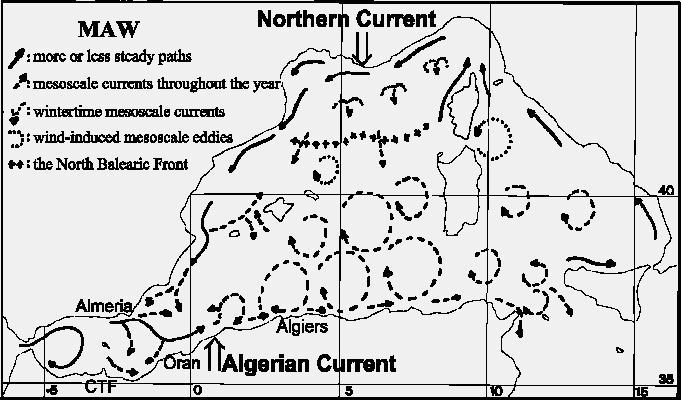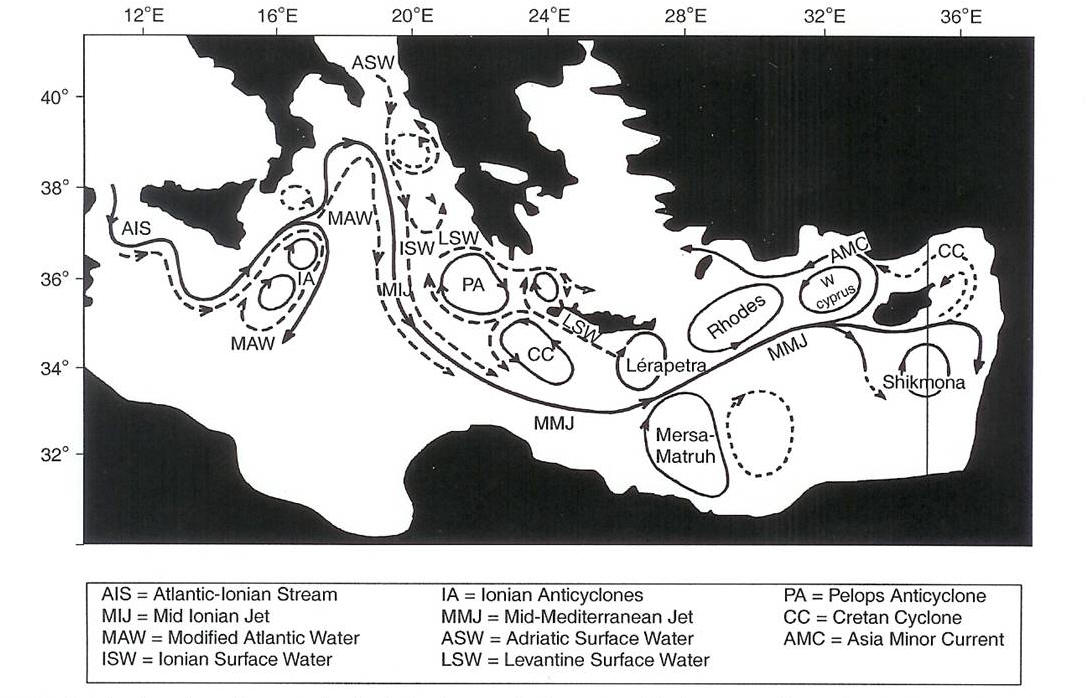OC4331-Mesoscale Oceanography
Final Project Summary
Topic Area
Mediterranean Mesoscale
Project Team Member
LT
Pierre-Yves Daré, French Navy
Major Findings
The Mediterranean Sea is a semi-enclosed almost isolated mid-latitude basin, defined by a complex coastline and a rugged bottom topography with numerous islands, bottom depressions and straits connecting the adjacent seas and the 2 major basins (western and eastern). The induced circulation is characterized by strong interactions between the basin-scale and mesoscale components. The general circulation, which is mainly counter-clockwise along the continental slopes, is crudely composed of the Algerian Current, the Corsican Current and the Northern Current in the western basin, and by stationary gyres in the eastern one.
The mesoscale activity especially consists in :
· 2 major fronts : the Almeria-Oran front separating Mediterranean and Atlantic surface waters and the North-Balearic front, both located in the western basin ;
· The Algerian eddies, which are generated by the Algerian Current instabilities and propagate first eastwards along the coast at a speed of few kilometers per day, before taking a northern path along the Sardinian slope. These eddies are both cyclonic and anticyclonic, but only anticyclonic ones are observed to increase in size (diameter of about 50-100 km, up to 250 km). They are characterized by deep vertical extent (up to the sea floor, about 2800 m), fast growing rate, rapid variability and lifetime ranges from months up to 3 years. They can also detach from the coast : this is most likely to happen in the vicinity of the Channel of Sardinia, where the narrowing and shallowing bathymetry constrains them to a northward path. The Algerian eddies eventually drift westward in the open basin for months. They often come back in the Algerian coast, where they interact with their parent current, potentially leading to dramatic perturbation of the general circulation. The AEs, which generally describe a counter-clockwise loop in the Algerian Basin, contribute to distribute over the whole basin the Levantine Intermediate Water coming from the eastern Mediterranean Sea by the Strait of Sicily ;
· Small (diameter of a few tens kilometers) shear cyclonic eddies and filaments, limited in depths and up to 100-200 km long, are observed between Algerian eddies and coastline breaks ;
· In the northern basin, anticyclonic and deep (between 100 and 1100 m, up to the whole depth) eddies, which have time and space scales of a few weeks and 10 km, respectively ;
· The "Leddies", by analogy with Meddies, are hypothesized by C.Millot [1999] as a result of the instability of the Levantine Intermediate Water vein as it passes the open SW corner of the Sardinian slope. These baroclinic eddies are supposed to transport Levantine Intermediate Water over the Algerian Basin interior, at depths between 200 and 600m. They could be an explanation of occurrence of recent LIW in the basin ;
· In the eastern basin, 40-80 km diameter eddies dynamically interact with the general circulation. Jets and filaments are also observed.
Some of the main mesoscale
experiments in the Mediterranean Sea are :
·
In the
western basin : MEDIPROD-5 (1986-1987), DYOME Experiment (1987-1988), MEDIPROD-6
(1990), EUROMODEL Experimental Studies (1990-1995), ELISA (1997-1998) ;
·
In the
eastern basin : POEM (1983-1990), POEM-BC (1990-1998).

Figure 1. Mesoscale features in the Western Mediterranean Sea

Figure 2. Sub-basin and mesoscale features in the Eastern Mediterranean Sea
References
Claude
Millot, 1991: "Mesoscale and seasonal variabilities of the circulation in
the western Mediterranean" Dynamics of Atmospheres and Oceans, Vol. 15 (April 1991),
179-214.
Allan R.
Robinson, Wayne G. Leslie, 2001: "Mediterranean Sea Circulation" Encyclopedia
of Ocean Sciences, Vol. 3, 1689-1705.
A.R.
Robinson, M. Golnaraghi, W.G. Leslie, A. Artegiani, A. Hecht, E. Lazzoni, A.
Michelato, E. Sansone, A. Theocharis and U. Unluata, 1991; "The eastern
Mediterranean general circulation : features, structure and variability" Dynamics
of Atmospheres and Oceans, Vol. 15 (April 1991), 215-240.
Claude
Millot, 2005: "Circulation in the Mediterranean Sea : evidences, debates
and unanswered questions" Scientia Marina, Vol. 69 (suppl. 1), 5-21.
Alban R.
Robinson and Kenneth H. Brink, 1998 : The Sea, Vol. 11, Chapters 4 and
30.
Matthias
Tomczak and J. Stuart Godfrey, 1994 : "The Eurafrican Mediterranean
Sea" Regional oceanography : an introduction, 300-309.
http://www.com.univ-mrs.fr/LOB/ELISA
|
This is a
government-maintained internet site. Please read the U.S. Navy web page disclaimer and the
disclaimer regarding external links. |
|